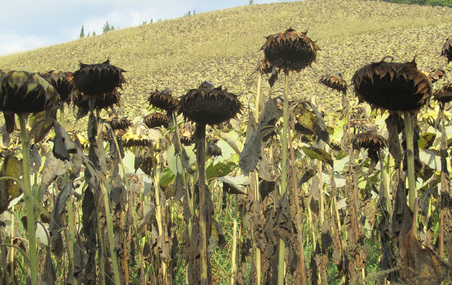 Heavy heads of sunflowers Heavy heads of sunflowers This morning we left Contignano, Toscana and drove over the mountains into the region of Le Marche, Italy. We were on our way to the location that would be our home for the next two months. Our track was a narrow mountain road that serves as the main artery from west to east. Originally built for carriages and carts, it is so narrow that in some villages the corners of the medieval stone buildings had to be cut away so the larger, modern-day trucks could squeeze through. Mountain scenery of woods and craggy cliffs eventually gave way to rolling hills and croplands with field after field of sunflowers just past their prime, their heavy heads bowed low, waiting for the (grim?) reaper. We happened upon one field that was still in full bloom and Jim snapped the picture included here. 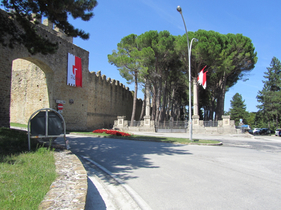 Porta Picena, San Ginesio Porta Picena, San Ginesio As arranged, we met our host, Omi, at the Porta Picena gate of the walled town of San Ginesio and followed her home. We had difficulty keeping up with her down the twisting, rough road. She had well adopted the Italian penchant for speed. The small estate, Casa Orchidea, where she, her husband, Nigel and their daughter spend their summers, is named for the tiny wild orchids that grow in the surrounding woods. The house, cantina, (our temporary abode) and vineyard are situated among rolling hills with patches of forests and stunning views of the Sibillini mountains. Just three kilometers away is the picturesque village of San Ginesio where we would visit regularly for our groceries, dinners out and caffé, especially on market day. 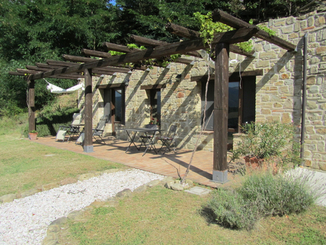 The Cantina The Cantina On our first night in the cantina, we sat outside in the warm air under an umbrella of stars and a perfect crescent moon, listening to a symphony performed by a thousand crickets. We could not take our eyes off the sky. So many stars! (plus a satellite or two). We were looking forward to our stay in this special place. Our responsibilities were to take care of the small vineyard, keep the gardens and grounds in shape and help with harvesting the grapes and wine making. It was a “house sitting” position we found through a website we had joined a year previous. After a few days of settling in and getting acquainted with our hosts, they returned to England and we were on our own. We began to investigate our environs. The first night was a visit to San Ginesio. We had pizza for dinner and headed for the car but got confused in the dark, unfamiliar town and could not find where we had parked. Feeling stupid to be lost in such a small place, we meandered the deserted alleys and passageways. Rounding one corner we came face to face(s) with what appeared to be hundreds cats! Huh? Were we seeing things? Had we drunk too much wine at dinner? At first unnerved, ready for a possible feline assault, we soon realized the kitties were just waiting for food to be put on the assortment of dishes on the ground. Laughing at our selves, we skirted the cat pack and continued on our quest to find our car. Finally successful we drove down the hill and back to our cozy cantina. Our first exploration was an interesting outing to say the least and a reminder of how many, many Italians are dedicated to caring for the indigent cat population. 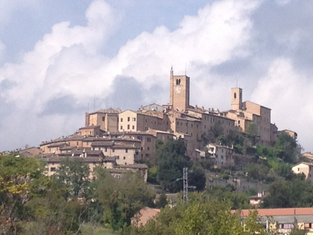 The hill town of Sarnano The hill town of Sarnano Whenever we had days with no tasks to attend to, we headed out to discover more of Le Marche. Like most areas of Italy, towns were built on hills for defense purposes. The hills are plentiful here and on every hill perches a town, most with their medieval walls intact. At first glance the towns seem similar but on closer inspection reveal their own unique identity. A caffé was a requisite part of our visit to a village and then a walk through the streets peeking in shops, museums and churches. We often enjoyed a chat with a local who was outside watering plants or out for a stroll. 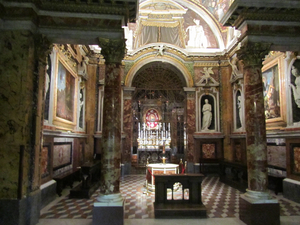 A view inside a "jewel box" A view inside a "jewel box" The churches were like jewelry boxes, the stark, unadorned facades opening to reveal the glittering of crystal and gold leaf, glistening stone columns and marble floors and colorful frescoes and mosaics. Most had a crypt with an elaborate coffin housing the proprietary saint (or a body part). These village visits were one of our favorite pastimes and the list of towns expanded to include such places as Amandola, Sarnano, Tolentino, Loro Piceno, Potenza, Ofida, San Severino and many, many more.  Inside the Palazzo Ducale, Urbino Inside the Palazzo Ducale, Urbino One of our more purposeful excursions was a visit to the town of Urbino. We had decided to spend the night and then head down the coastline of the Adriatic the next day. Urbino is most known for the huge, imposing Renaissance Palazzo Ducale of Frederico da Montefeltro. The size and splendor of this castle is impressive. We roamed the halls and salons and found most interesting the warren of kitchens, laundry rooms and stables in the sotteranei (basements). In these cellars, during the Second World War, 6,000 pieces of art were successfully hidden from the Nazis. Today the palace houses the Galleria Nazionale delle Marche. In the evening we found a restaurant tucked away on a backstreet. Empty at first it soon filled with locals and we enjoyed one the best meals of our stay in Le Marche. 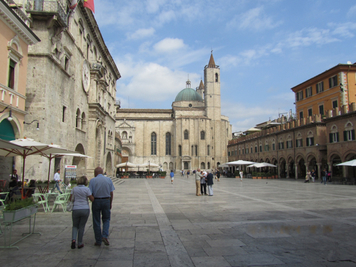 Piazza Popolo, Ascoli Piceno Piazza Popolo, Ascoli Piceno Another planned outing was a visit to the town of Ascoli Piceno. As often happened during our travels in this region, we had trouble finding our way, at least the route we had mapped out. Although frustrating at the time, it led to unexpected discovery and we always, eventually, reached our ultimate destination. The origin of Ascoli Piceno can be traced to the indigenous people of Italy, the Sabini. The center of the social life of the community is the beautiful Renaissance Piazza Popolo located on the site of the Roman forum constructed when the town was conquered by the Romans in 89 BC. The buildings surrounding the piazza are built with the native travertine stone and symbolically represent the three powers that be, religious (Church of San Francesco), political (Piazza dei Capitani) and commercial (Loggia dei Mercanti). We sat outside the beautiful and venerable Caffe’ Meletti watching the activity of life playing out before us on this travertine paved piazza. Of course we could not leave before buying a paper cone filled with the famous Olive all’ Ascolana from a street vendor. These tasty morsels are large olives stuffed, usually with salami, and then deep-fried. They are a famous gastronomical product of Ascoli Piceno. There is so much more I want to tell you about our amazing time in Le Marche. In my next blog post I will describe our experience of the grape harvest and the making of wine, our exploits into the Sibillini mountains, the ruins of the Roman town of Urbs Salvia, the beaches along the Adriatic coast and the people we met and friends we made.
Ciao e grazie, Andrea I am putting together a tour to Le Marche, probably in 2017. Are you interested? Write to me at [email protected] or use the contact page at travelinitalia.com
1 Comment
Deb
9/10/2015 06:32:12 am
This is incredible, Andy. You made me really want be there with you, while at the same time giving me a lovely taste of your experience. Deep fried olives stuffed with salami? My mouth waters.
Reply
Leave a Reply. |
Andrea Aldrich
I am an artist, teacher and avid traveler. I love to share with like-minded individuals my favorite European country— Italy. Archives
April 2020
Categories |




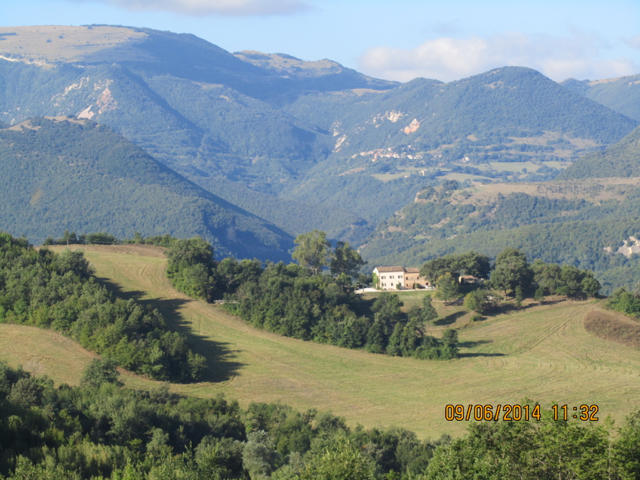
 RSS Feed
RSS Feed
